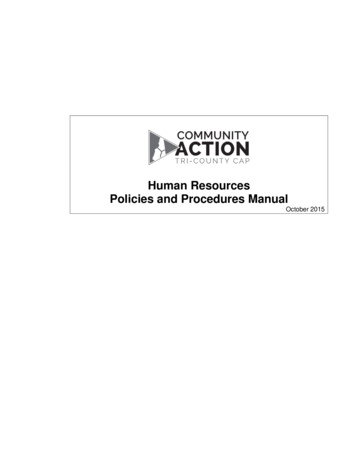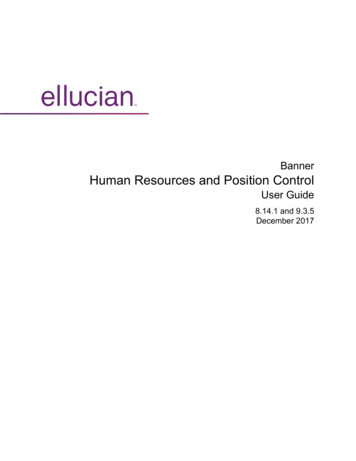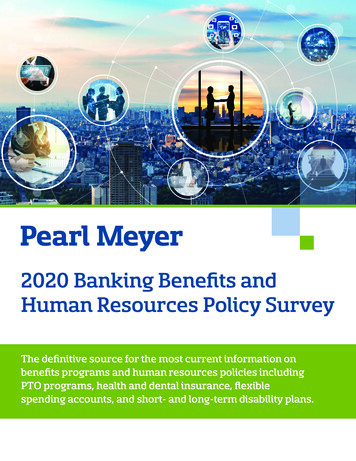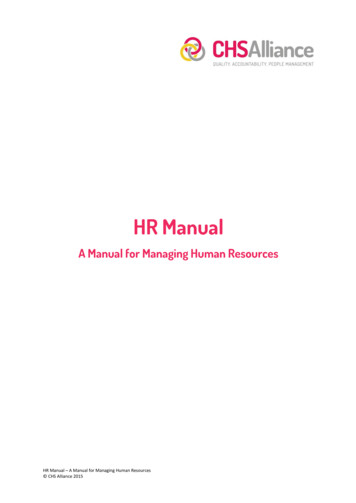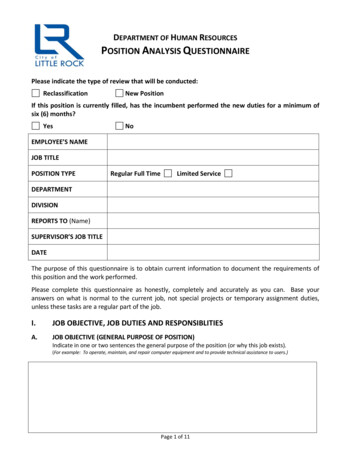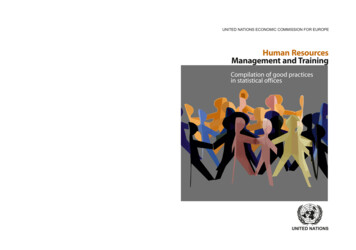
Transcription
Compilation of good practicesin statistical officesThe publication is available online atwww.unece.org/statsHuman ResourcesManagement and TrainingCompilation of good practicesin statistical officesHuman Resources Management and TrainingHuman ResourcesManagement and TrainingUNECE UNECE / FAOThis compilation provides 24 papers on goodpractices in human resources managementand training in statistical offices from acrossthe UNECE region, grouped into threesections: cross cutting issues, training, andhuman resources management. The paperscover a range of issues from recruitment andretaining of staff and setting up trainingprograms, to competence mapping andmanagement development.UNITED NATIONS ECONOMIC COMMISSION FOR EUROPEUNITED NATIONSUNITED NATIONS
UNITED NATIONS ECONOMIC COMMISSION FOR EUROPEHuman ResourcesManagement and TrainingCompilation of Good Practicesin Statistical Offices
United NationsNew York and Geneva, 2013NOTEThe designations employed and the presentation of the material in this publication do not imply theexpression of any opinion whatsoever on the part of the Secretariat of the United Nations concerningthe legal status of any country, territory, city or area, or of its authorities, or concerning the delimitationof its frontier or boundaries.ECE/CES/28
PREFACEIn an era of technological, social and economic change, statistical offices are facing severalchallenges to further develop their key role as provider of high-quality information oneconomic, social and environmental phenomena. These include the need to meet both currentand future demands of the users of statistics and to develop production processes thatincrease efficiency of work and reduce costs.New technologies and new organisational arrangements are fundamental in this respect. Thisis why the High-Level Group on Modernisation of Statistical Production and Services,established under the auspices of the Conference of European Statisticians, is developing anintegrated approach to update production processes and statistical outputs.In this context, human resources are the most important asset of statistical offices.Appropriate and skilled human resources are essential to ensure the production of highquality statistics and to implement more efficient and effective production processes based onnew technologies. Proactive human resources management is essential to achieve theabovementioned change and to allow statistical offices to meet the challenges today and infuture.This volume includes 24 papers highlighting good practices in human resources managementand training in statistical offices. The papers cover a range of issues from recruitment andretaining of qualified staff and setting up training programmes, to competence mapping andmanagement development. These papers have been presented at seminars and workshops onhuman resources management and training from 2006 to 2012, organised on the initiative ofthe Conference of European Statisticians.It is my hope that the Compilation will be useful for the work on human resources in statisticaloffices in their transition to more efficient and effective working methods.Mr. Enrico GiovanniniChairman of the Conference of European Statisticiansiii
CONTENTSNote . IIPreface .IIIContents.VAcknowledgements . VIICross‐cutting issues1. Future Challenges in Human Resources Management and Training in National Statistical Offices . 1Wouter Jan van Muiswinkel, Statistics Netherlands2. Strategic Personnel Planning. 11Wouter Jan van Muiswinkel, Statistics Netherlands3. Strategy Based HR Management in Practice ‐ Experience of Statistics Finland . 21Hanna Bärlund, Heli Jeskanen‐Sundströmand Anna‐Leena Reinikainen, Statistics Finland4. Statistical Excellence Through Capability Development and Planning . 31Chris Libreri, Australian Bureau of Statistics5. Managing Human Resources in a Small Statistical Office . 39Blagica Novkovska, State Statistical Office of the Republic of MacedoniaTraining6. E‐learning System in STI, Statistics Korea: Achievements and Challenges . 53Kyung ae Park, Statistics Korea7. Setting up In‐house Training: Some Issues to Consider .65Dag Roll‐Hansen, Statistics Norway8. Training Programme in Statistical Skills .85Riikka Mäkinen, Statistics Finland9. Theory and Practice in the Comprehensive Training Programme . 101Imre Dobossy, Eszter Viragh and Gabor Apati, Hungarian Central Statistical Office10. Towards a European Master in Official Statistics. 109Anne Kofoed, Marius Suciu and Marcus Zwick, EUROSTAT11. Moving from Introduction Towards Integration of New Employees – Objectives and Methods . 117Ingvild Maanum Möller, Statistics Norway12. Management Development . 125Martin Lagerström, Statistics Sweden13. From Competences to Awareness: Management Development . 139Antonio Ottaiano, Federica Navarra,Cecilia Colasanti and Fabrizio Rotundi, National Institute of Statistics of Italy14. ABS Leadership and Management Charter and the Senior Executive Program . 163Chris Libreri, Australian Bureau of Statisticsv
Human Resources Menagement15. Recruiting and Retaining Qualified Staff at Statistics Finland . 169Elina Pääkkö, Statistics Finland16. Mobility and Knowledge Sharing . 187Marleen Verbruggen and Adrie Ykema, Statistics Netherlands17. Becoming an Attractive Employer for Future Employees: Some Experiences from Statistics Norway . 197Rita Braziunaite, Heidi Torstensen and Jan Byfuglien, Statistics Norway18. Learning and Development in Challenging Times . 207Anne Kofoed and Mats Olsson, EUROSTAT19. A Competence Profile for Staff Supporting the European Statistical System . 215Wesley Miles, UK National Statistician’s OfficeSilvio Stoppoloni, National Institute of Statistics of ItalyAlexandra Molcuti, National Institute of Statistics of RomaniaVeronika Radermacher, EUROSTATWouter Jan van Muiswinkel, Statistics NetherlandsYolanda Gomez, National Statistics Institute of Spain20. Why and How to Improve Competence Descriptions and Evaluations in a Statistical Institute? . 227Jan Byfuglien and Beate Johnsen, Statistics Norway21. Beyond Vocational Training ‐ Competence Management at Statistics Sweden. . 233Crister Haglund, Statistics Sweden22. Statistics Finland’s Personnel Survey . 241Anne Lahdenperä‐Seunavaara, Statistics Finland23. The Improvement of HR Management by Using Lean . 253Jan Byfuglien, Heidi Torstensen and Anne Trolie, Statistics Norway24. Methods and Main Results of Staff Migration Motivation Research . 261Eszter Viragh, Hungarian Central Statistical Officevi
ACKNOWLEDGEMENTSIn 2010, the Bureau of the Conference of European Statisticians (CES) agreed that a workshop onHuman Resources Management and Training (HRMT) in statistical offices should be organised to takeplace in 2012. The aim of this workshop was to discuss current and upcoming issues for HRMT instatistical offices, and follow-up on issues discussed at previous CES workshops on HRMT. Leading onfrom this, it was requested by the Bureau that concrete outputs directed towards the creation of acompilation of good practices in HRMT.At the HRMT workshop in Budapest in September 2012, the participants supported the initiative toproduce a compilation of good practices and agreed it should be based on selected papers from theHRMT seminar at the CES plenary session in 2006 and the following HRMT workshops in 2008 (Skopje),2010 (Geneva) and 2012 (Budapest). The selected papers should be of general relevance and addresscurrent and future challenges in both human resources management and in training.The final selection of 24 papers for the compilation was made by the co-chairs of the 2012 HRMTworkshop, Statistics Netherlands and the Central Statistical Office of Poland on basis of the proposals ofthe participants of the workshop. After the selection of the papers, the authors were contacted andasked to review and update their papers where necessary. The papers have been grouped in threesections in the compilation: cross cutting issues, training, and human resources management, accordingto the main theme of the papers.The following authors have provided papers for the compilation:Australian Bureau of StatisticsChris LibreriState Statistical Office of the Republic ofMacedoniaBlagica NovkovskaEurostatAnne Kofoed, Marius Suciu, Marcus Zwick, MatsOlsson and Veronika RadermacherStatistics NetherlandsWouter Jan van Muiswinkel, MarleenVerbruggen and Adrie YkemeStatistics FinlandHanna Bärlund, Heli Jeskanen-Sundström,Anna-Leena Reinikainen, Riikka Mäkinen, ElinaPääkkö and Anne Lahdenpera-SeunavaaraStatistics NorwayDag Roll-Hansen, Ingvild Maanum Möller, RitaBraziunaite, Heidi Torstensen, Beate Johnsen,Anne Trolie and Jan ByfuglienHungarian Central Statistical OfficeImre Dobossy, Eszter Viragh and Gabor ApatiNational Institute of Statistics of RomaniaAlexandra MolcutiNational Institute of Statistics of ItalyAntonio Ottaiano, Federica Navarra, CeciliaColasanti, Fabrizio Rotundi and SilvioStoppoloniNational Statistics Institute of SpainYolanda GomezStatistics SwedenMartin Lagerström and Crister HaglundStatistics KoreaKyung ae ParkUK National Statistician’s OfficeWesley MilesWouter Jan van Muiswinkel, Carina Fransen and Ineke Van Der Stoel, Statistics Netherlands, AnnaBorowska, the Central Statistical Office of Poland, and Tetyana Kolomiyets and Charlotte Hadden,UNECE, undertook the selection and review of the papers. The compilation was edited and prepared forprinting by Tetyana Kolomiyets and Charlotte Hadden, UNECE.vii
Future Challenges in Human Resources Management and Training in National Statistical Offices1. FUTURE CHALLENGES IN HUMAN RESOURCES MANAGEMENT ANDTRAINING IN NATIONAL STATISTICAL OFFICESWouter Jan van MuiswinkelStatistics NetherlandsINTRODUCTIONThe Conference of European Statisticians (CES) at its plenary session in 2006 conducted a seminar onhuman resources and training in statistical offices. The seminar concluded that human resources andtraining are crucial elements for the successful fulfilment of the mission of the offices and that there wasa need to continue the exchange of experience in the area of human resources and training. Hence, as afollow-up to the CES seminar, workshops on human resources management and training (HRMT) wereorganised in 2008, 2010 and 2012 where a number of issues in HRMT were discussed.This paper takes a forward looking approach and provides an outline of the future challenges in thearea of HRMT for statistical offices. The paper draws on the discussions at the HRMT workshop in 2012and incorporates issues that were raised by countries during the workshop. The paper also draws on1information collected through a survey to CES member countries on their practices and plans in HRMT.Section 2 provides a brief overview of the strategic directions for HRMT, including also the challengesraised by the High-level Group on Modernization of Statistical Production and Services. Section 3 lists anumber of key challenges to the statistical offices and, on this basis, a number of areas in HRMT thatwill be particular important in the future. Section 4 groups the main elements of HRMT according towhether they are primarily operational, tactical or strategic. This grouping can be used to assess currentHRMT activities and may also be used for planning of future developments in HRMT. Annex 1 providesa summary table of the results of the 2012 survey on HRMT to CES member countries.STRATEGIC DIRECTION FOR HRMTThe economic, technical and social changes in society pose challenges and possibilities for nationalstatistical offices (NSOs). With the development of the information society the amount of (electronic)information that is available has increased dramatically. The way in which information can be accessedand exchanged has also changed and become much more global. There is no evidence that thesedevelopments and changes will not continue in future, and NSOs will need to be active in developingtheir ways of produ
new technologies. Proactive human resources management is essential to achieve the abovementioned change and to allow statistical offices to meet the challenges today and in future. This volume includes 24 papers highlighting good practices in human resources management and training in statistical offices. The papers cover a range of issues from recruitment and

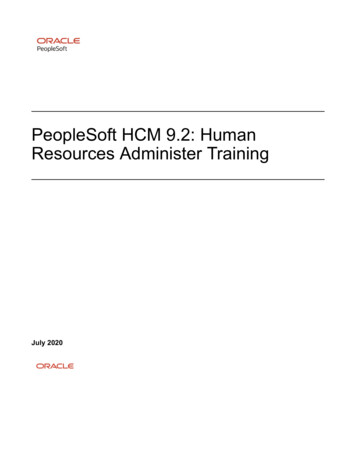
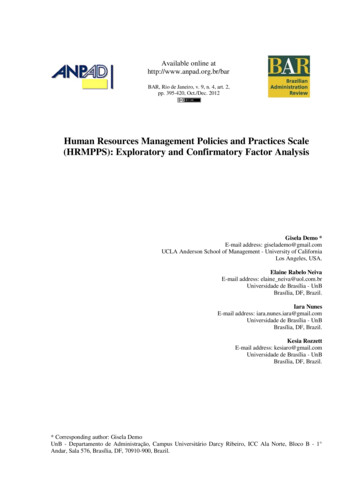

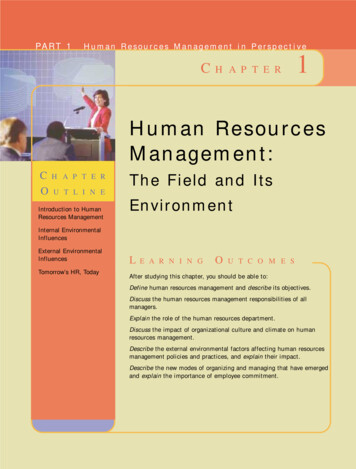
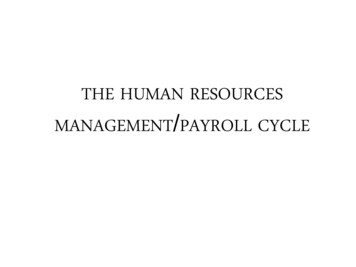
![[IV‐ADV‐9‐A] Tips and Tricks for Payroll and Human Resources](/img/9/tips-and-tricks-payroll-and-hr.jpg)
